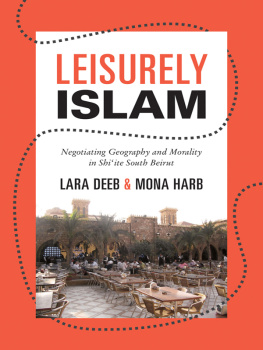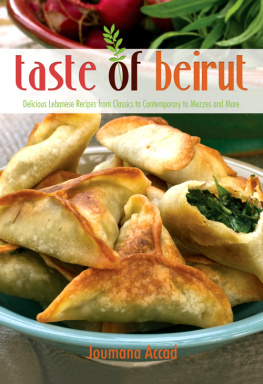
Leisurely ISLAM
PRINCETON STUDIES IN MUSLIM POLITICS
Dale F. Eickelman and Augustus Richard Norton, series editors
A list of titles in this series can be found at the back of the book
Leisurely ISLAM
Negotiating Geography and Morality in Shiite South Beirut
Lara Deeb & Mona Harb
PRINCETON UNIVERSITY PRESS
Princeton and Oxford
Copyright 2013 by Princeton University Press
Published by Princeton University Press, 41 William Street, Princeton, New Jersey 08540
In the United Kingdom: Princeton University Press, 6 Oxford Street, Woodstock, Oxfordshire OX20 1TW
press.princeton.edu
All Rights Reserved
Library of Congress Cataloging-in-Publication Data
Deeb, Lara, 1974
Leisurely Islam : negotiating geography and morality in Shiite South Beirut / Lara Deeb and Mona Harb.
pages cm (Princeton studies in Muslim politics)
Includes bibliographical references and index.
ISBN 978-0-691-15365-0 (hardcover : alk. paper) ISBN 978-0-691-15366-7 (pbk. : alk. paper)
1. LeisureLebanonBeirut. 2. ShiitesLebanonBeirut. 3. Recreation areasLebanonBeirut. 4. LeisureReligious aspectsIslam. I. Harb, Mona. II. Title.
BJ1498.D324 2013
| 306.48120956925dc23 | 2012049867 |
British Library Cataloging-in-Publication Data is available
This book has been composed in Stempel Garamond
Printed on acid-free paper.
Printed in the United States of America
10 9 8 7 6 5 4 3 2 1
Contents
Figures
Preface and Acknowledgments
This book began with a conversation on a bench at the American University of Beirut in July 2002; it began with a friendship that grew into a research collaboration, and became a collaboration that nurtured that friendship. We had met earlier, in February 2000, while we were each doing fieldwork (and in fact, interviewing the same person back-to-back) on different topics related to south Beirut. But that conversation in summer 2002, which tacked between work and life, solidified what is certain to be a lifelong friendship and inspired this project, which we are now seeing to its conclusion.
Our collaboration began as an exploration of what we call the Shii Islamic milieu in Lebanon. Early research took us to Khiam in the South, the Bekaa Valley, and all around south Beirut. Our field research was violently interrupted by the 2006 Israeli war on Lebanon. Following that war, the caf sector in the area became strikingly visible in new ways. We narrowed our focus to leisure, and even more specifically, the emerging ideas as well as practices of morality and space that are both producing and being produced by new leisure places in south Beirut. Looking back at our notes, our initial desires for our collaboration ranged from answering the question Why is Hizbullah investing in entertainment projects? to showing that the party is only one piece of the vibrancy of everyday life in south Beirut. In the end, we were inspired by Lebanese politics and specifically an advertising campaign positing a culture of death against those who love life. We wanted to show the different ways that people can and do enjoy themselves in different parts of the city. We wanted to treat leisure as something that is, on the one hand, as disciplined as other aspects of life, and on the other hand, an arena for potential dissonance. We hope that the chapters that follow accomplish some of that.
The research and writing of this book have benefited from several generous sources of funding, for which we are grateful. These included funding from the University of California at Irvine, the American University of Beirut, Scripps College, a Wenner-Gren International Collaborative Research Grant, and an American Council of Learned Societies Collaborative Research Fellowship.
We are thankful to many individuals who shared their knowledge with us: Ali al-Daher from the Lebanese Arts Association, Ghassan Darwish from Hizbullahs Media Office, Abdul-Halim Fadlallah from the Consultative Center for Studies and Documentation, member of Parliament Ali Fayyad, and Ghobeyris mayor Muhammad Said al-Khansa. We are also grateful for the help of Sayyid Jafar Fadallah (the son of the late Sayyid Muhammad Hussein Fadlallah) along with the representatives of Sayyid Khamenei and Sayyid Sistanis offices as well as the rapid email responses of the staff at Fadlallahs Web site. We thank all the caf owners, managers, and land brokers we interviewed as well as the waiters (and few waitresses) with whom we had informal conversations. We particularly thank Adham Tabaja from al-Inmaa Group and Jamal Makki from al-Saha Traditional Village.
The data for this book were collected with help from a fabulous team of research assistants. We warmly acknowledge Fatima Koumeyha, Lamia Moghnieh, Hazar al-Asadi, Tala A. Rahmeh, and Sara Aslam Dada. Nidal al-Azraq provided invaluable transcription assistance. We especially appreciate the outstanding work of Douaa Sheet on several research tasks and aid of Diala Dagher, who responded consistently to our numerous requests.
The maps in this book were conceived and designed by Ahmad Gharbieh. Working with him was a rewarding experience, and we thank him for helping us represent our data with such rigor and clarity, and teaching us how to think with mapping tools. We also thank Wissam Bou-Assi for her patience and dedication in executing these maps.
For reading and commenting helpfully on our work in various forms, we thank Lori Allen, Hiba Bou-Akar, Sherine Hafez, Howayda al-Harithy, Dina al-Kassim, Mazen Labban, Pardis Mahdavi, Samuli Schielke, and Chris Toensing. We are especially grateful to Esra Ozyurek, who turned her careful and pragmatic eye on the full manuscript. For useful comments and inspiring conversations, we thank Asad AbuKhalil, Kamran Ali, Talal Atrissi, Fadi Bardawil, Asef Bayat, Azza Charara-Beydoun, Teresa Caldeira, Ghassan Hage, James Holston, Zeina Maasri, Sofian Merabet, Maya Mikdashi, Richard Norton, Diane Riskedahl, Ananya Roy, Nezar Al-Sayyad, Nadya Sbaiti, Kirsten Scheid, Abdou-Maliq Simone, Susan Slyomovics, Fawwaz Traboulsi, Jessica Winegar, and too many lecture audiences to list.
At Princeton University Press, we appreciate Fred Appels trust and editorial eye, and the diligence and patience of his assistant Sarah David, production editor Sara Lerner, copyeditor Cindy Milstein, and indexer Jan Williams, as well as the helpful comments of two anonymous reviewers. It should go without saying that all flaws remain our own.
For their friendship in Lebanon, we are ever grateful to Dia Abou-Mousleh, Mona Fawaz, Vienna Khansa, Haitham Khoury, Zeina Maasri, and Michel Sawaya (who also helpfully explained Lebanese real estate). Haitham in particular has been a generous (and always fun!) host for Lara in Beirut many times. In part, we owe the pleasure of working together to a mutual dear friend, Nadya Sbaiti, who prompted our conversation on an American University of Beirut bench years ago, accompanied us to a couple interviews, hung out in cafs, shared ideas, read pieces, kept us both sane separately and together, and always believed in this book.
There have also been myriad coffees, lunches, and dinners with our partners, Qutayba Abdullatif and Sami Atallah, in Beirut, San Diego, and Los Angeles. They were sometimes accosted with questions like What does this dcor make you think of? Do you like it? Tayyib, [OK] why? Tayyib, why not? We thank them for tolerating our passion for ethnographynot always an easy task for the quantitatively inclined.
Mona thanks Sami for his unconditional love, amid the wails, smiles, laughter, yells, and billion requests of our beautiful little princess, Yasmine, and her high-maintenance big brother, Nadim. This book bears witness to the painstaking process that brought us together, from Hamra all the way to Manhattan and back. And Mona also thanks her parents, Sami and Salma, for their unfailing support and care.
Next page






